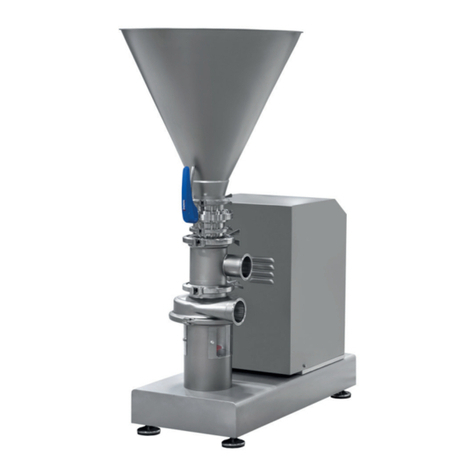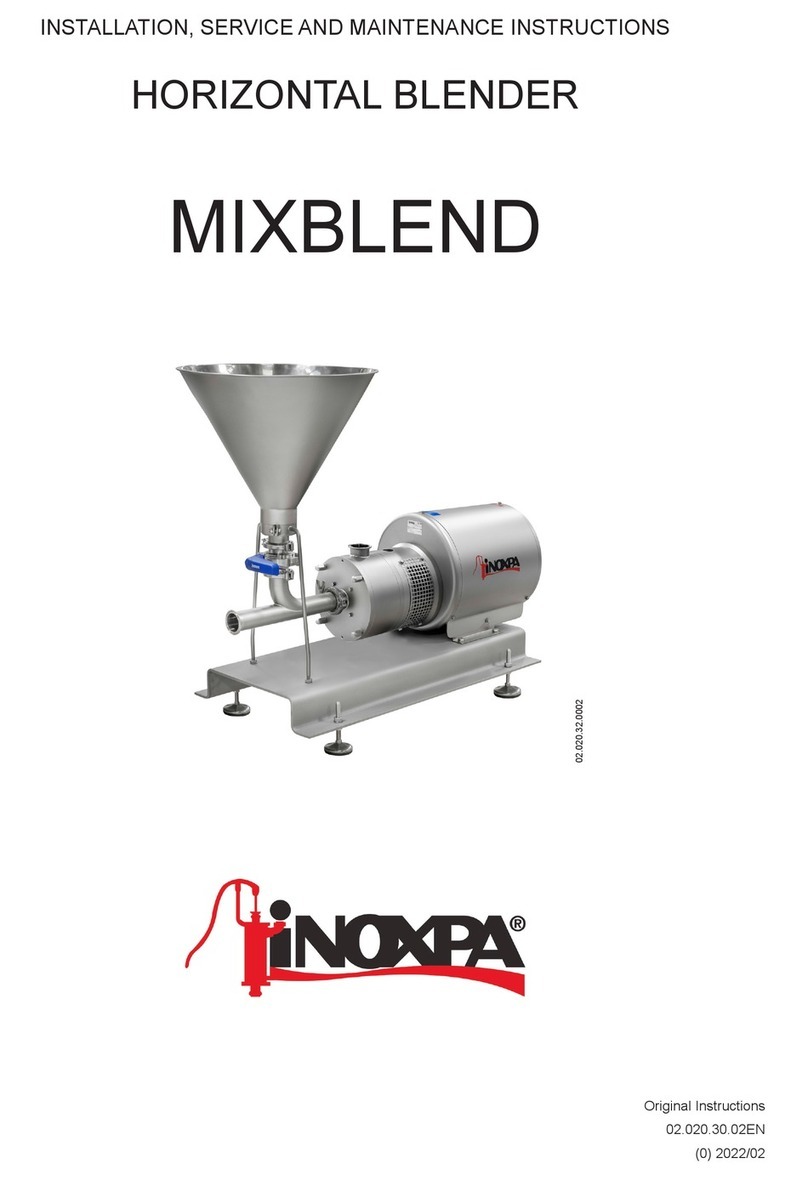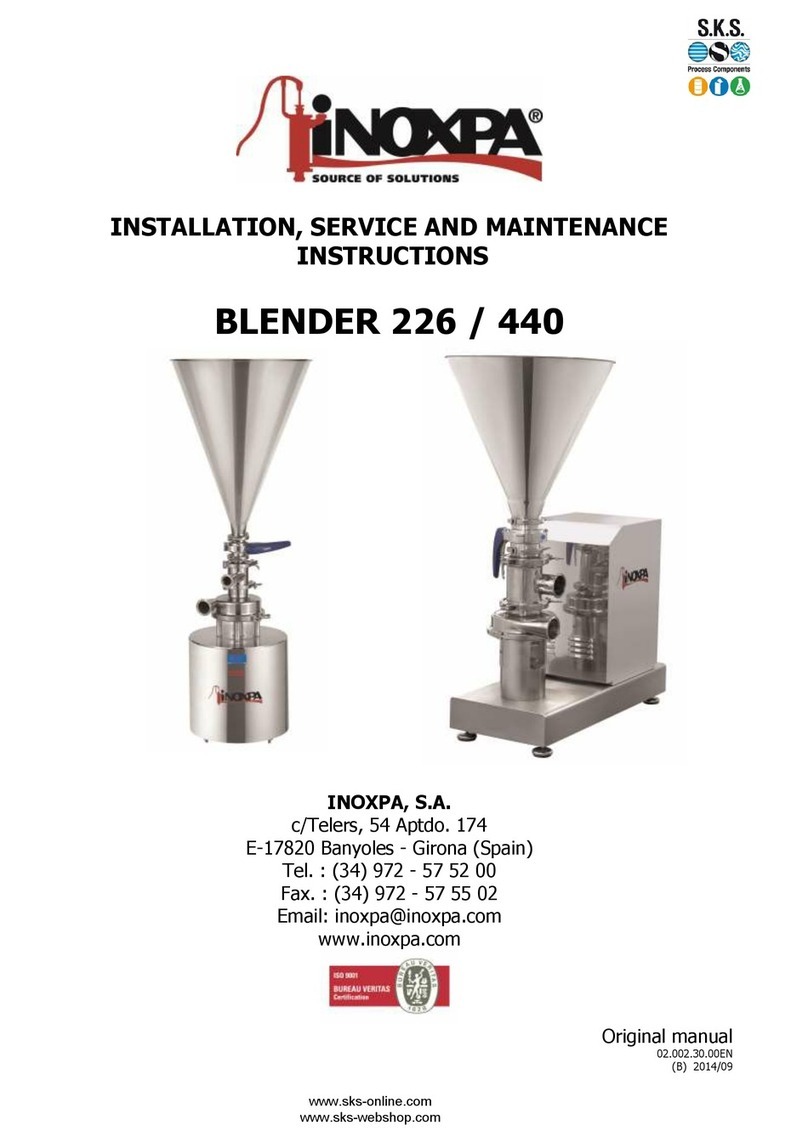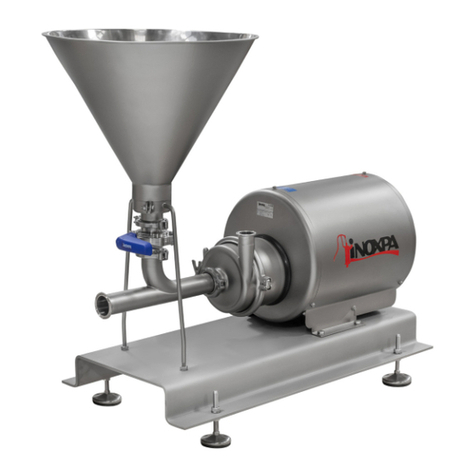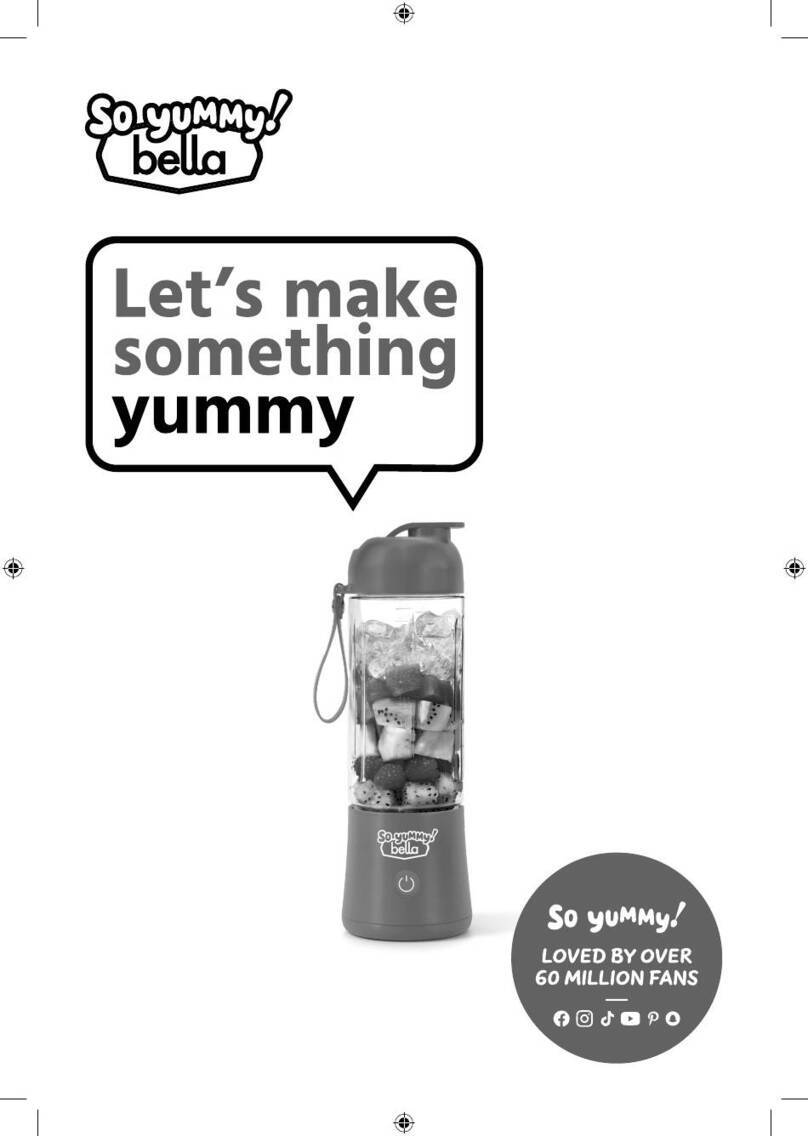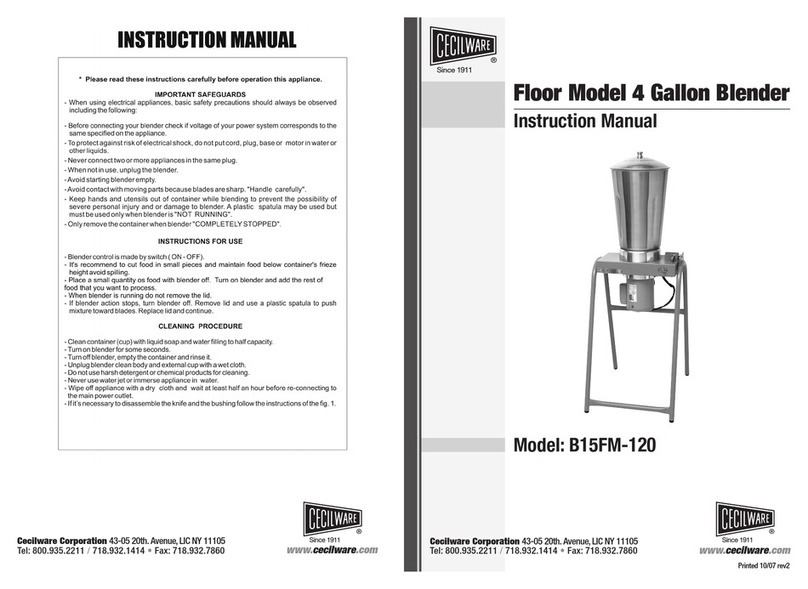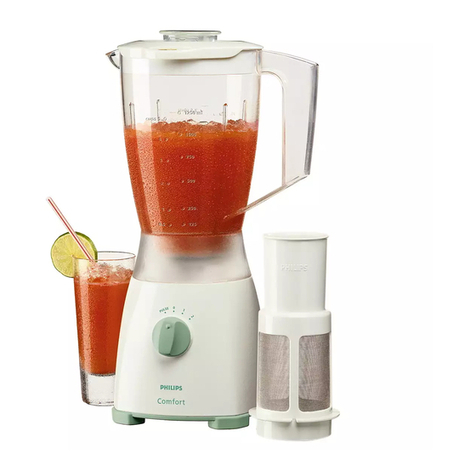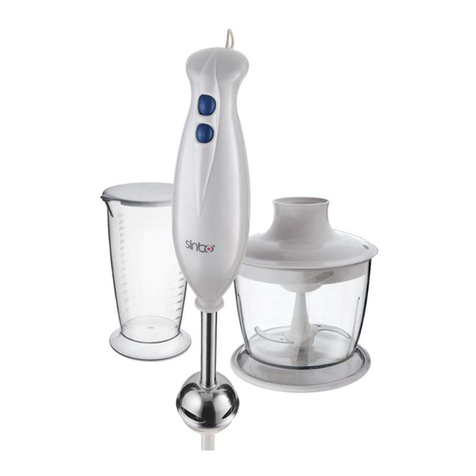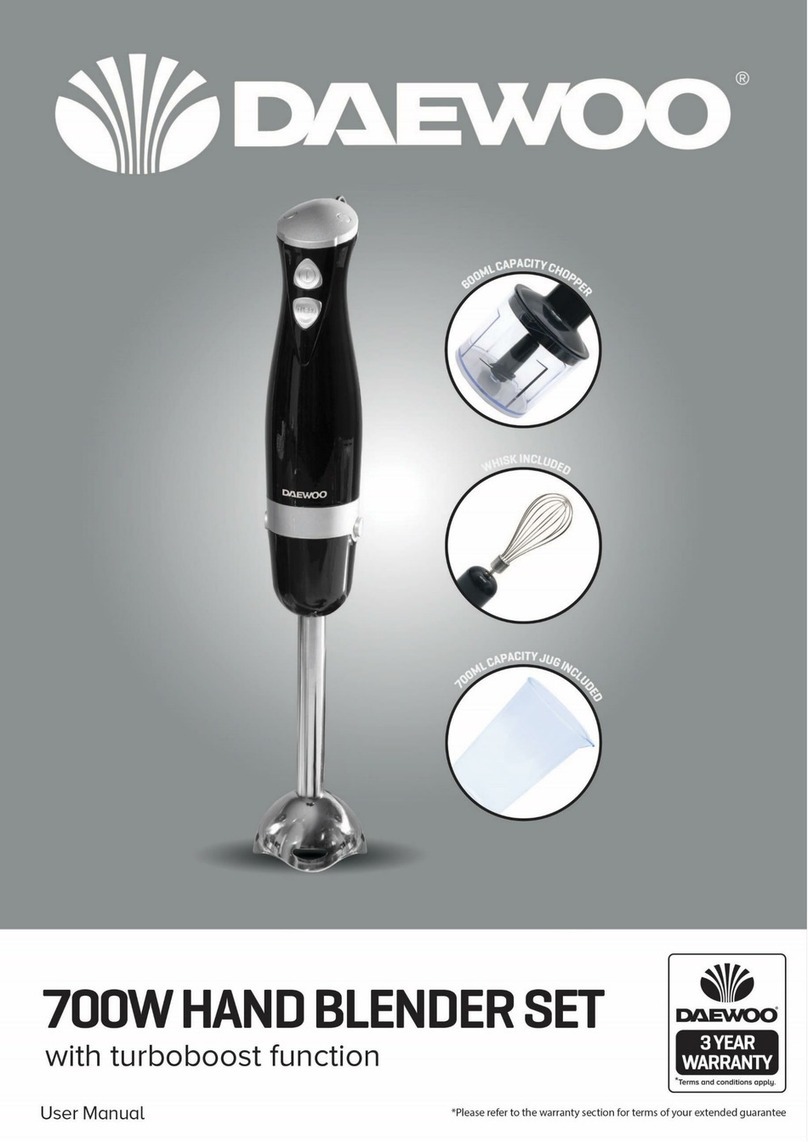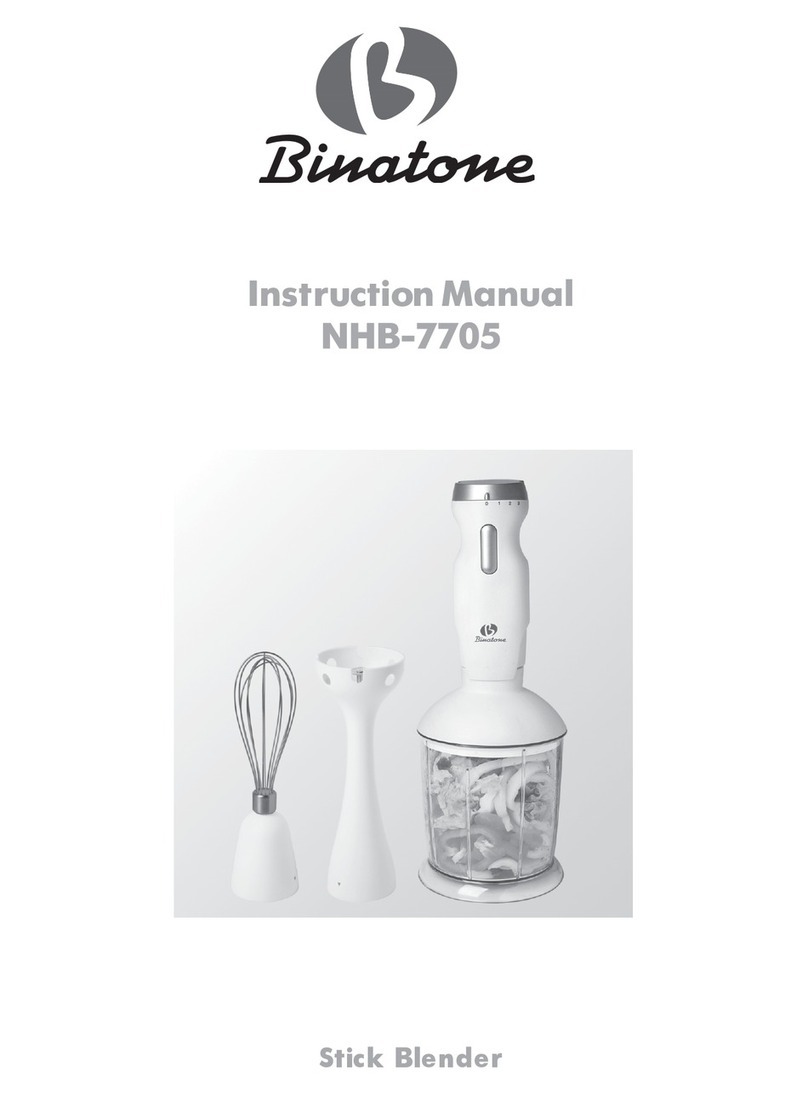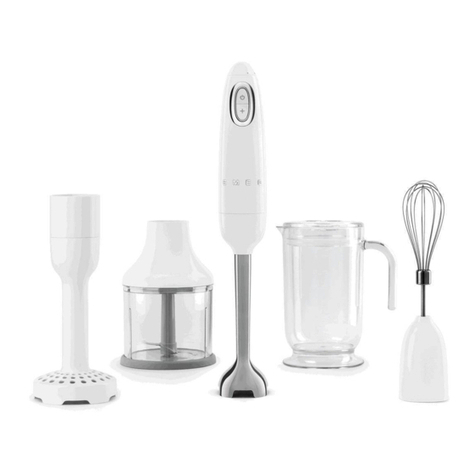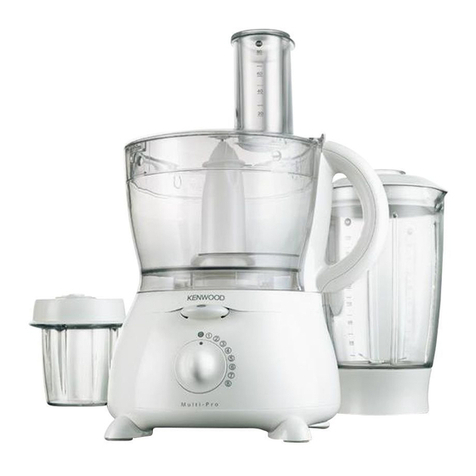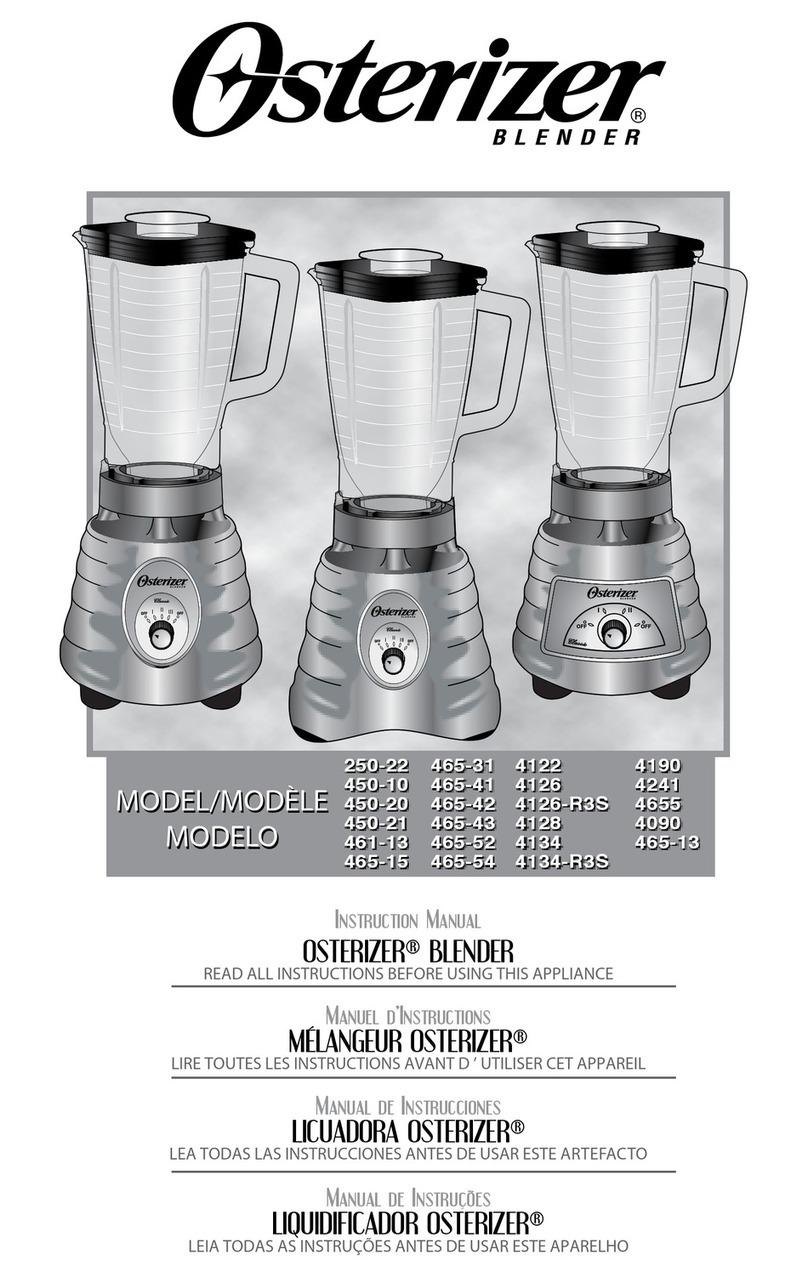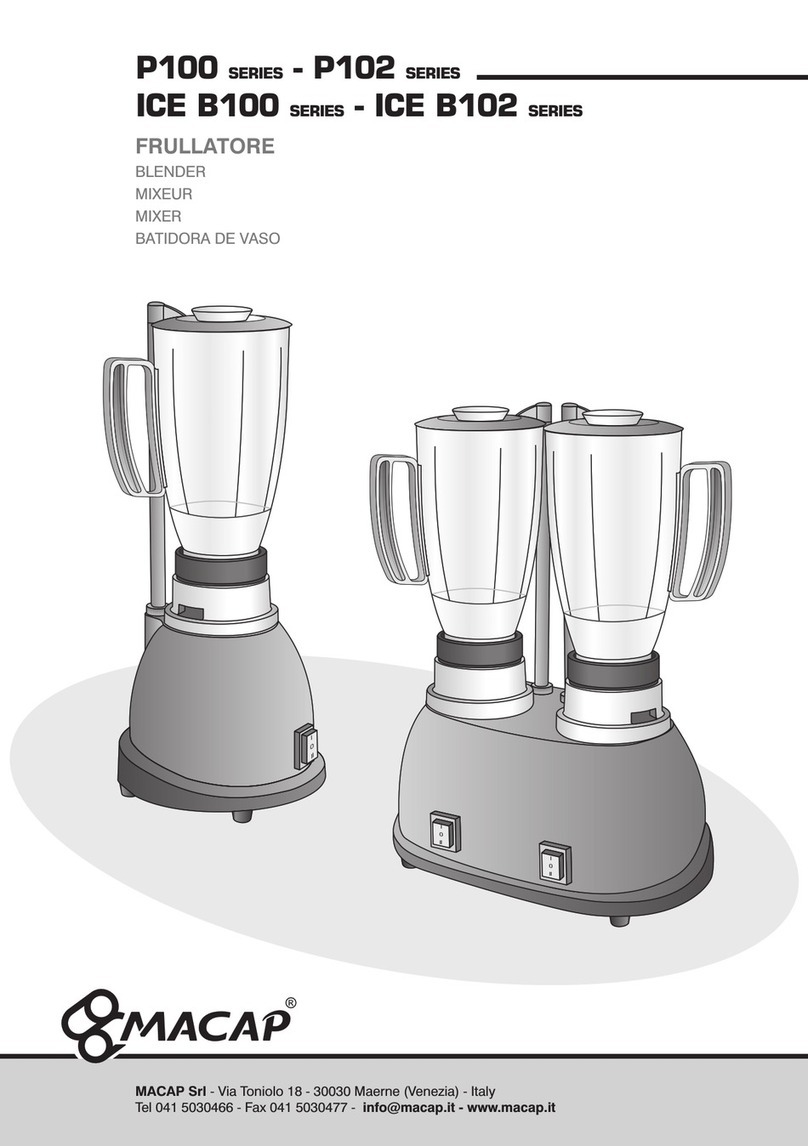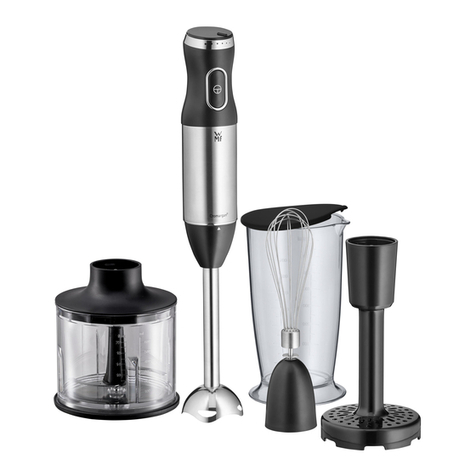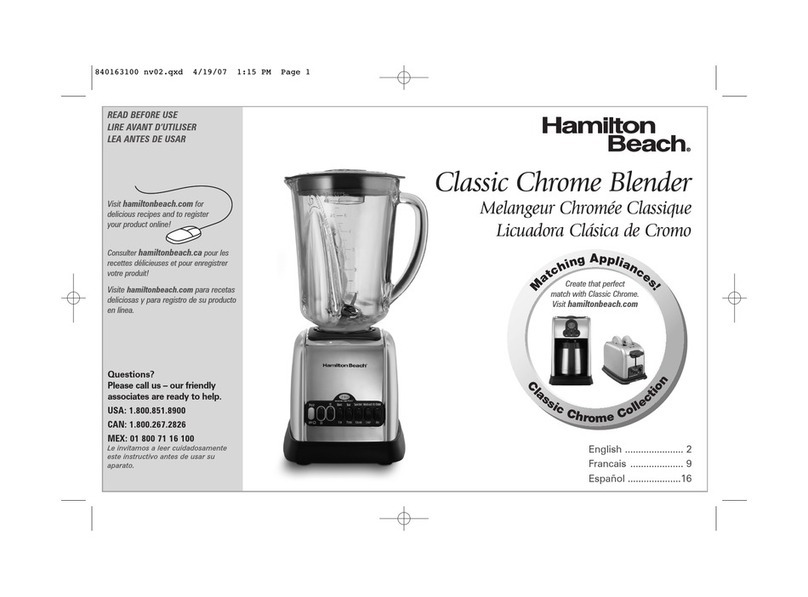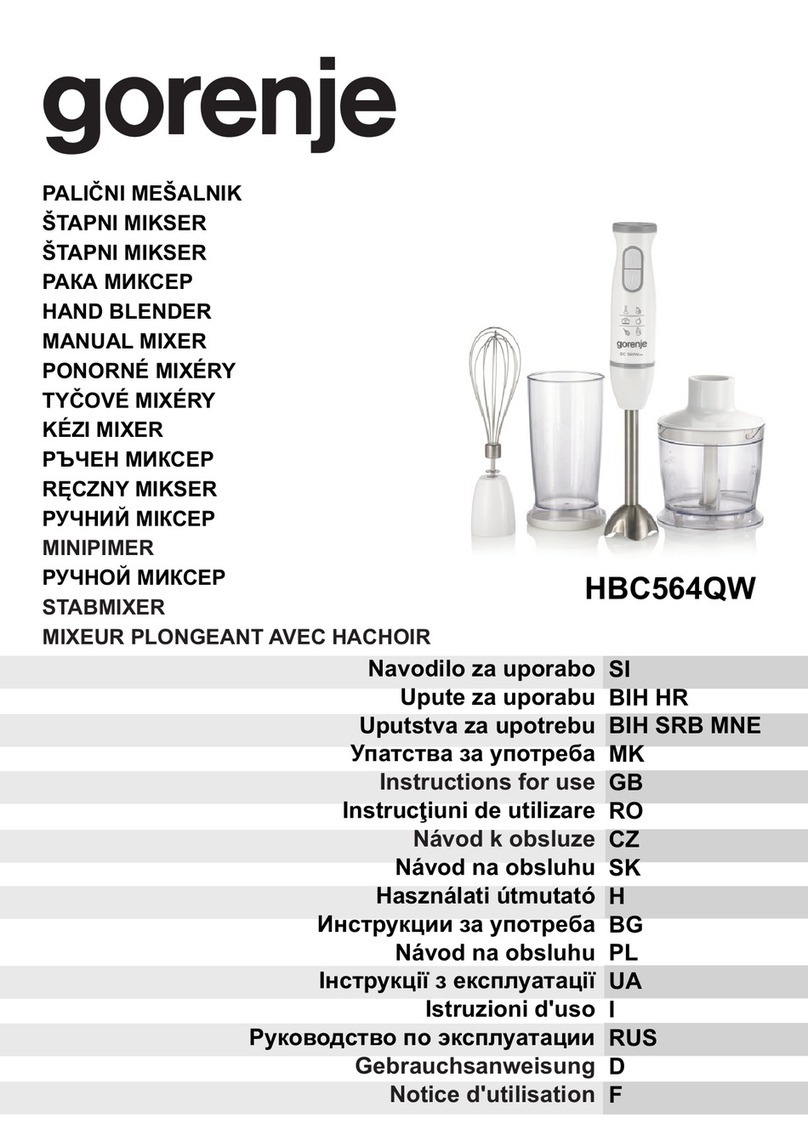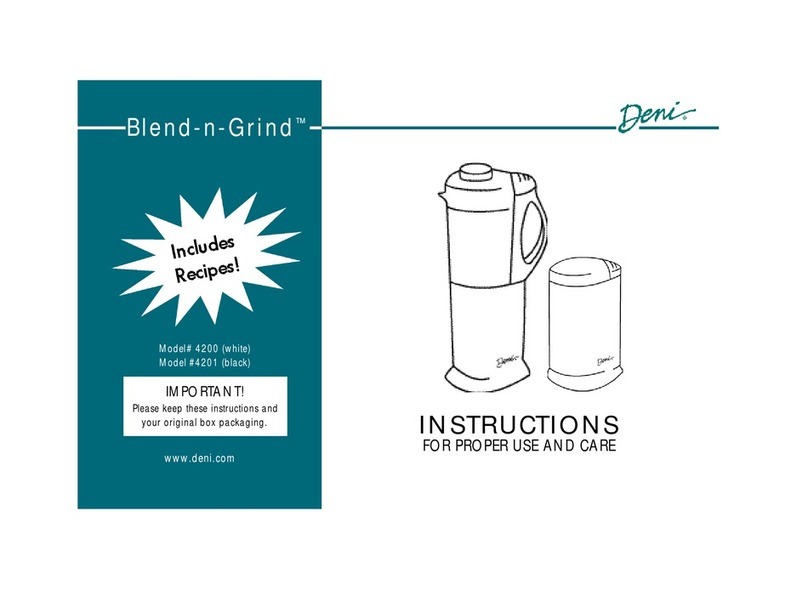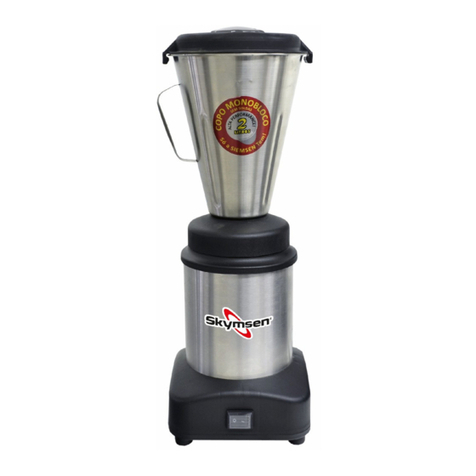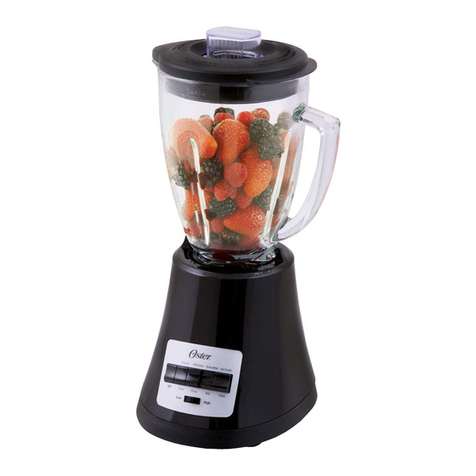INOXPA MM Manual

INSTALLATION, SERVICE,
AND MAINTENANCE INSTRUCTIONS
ANNEX FOR CE MARKED EQUIPMENT IN
ACCORDANCE WITH DIRECTIVE 2014/34/EU
MM Ex TABLE BLENDER
The content of this annex supplements the information contained in
the instruction manual. The instructions in this annex must always be
considered as supplementary for equipment marked in accordance
with directive 2014/34/EU.
This annex is to be used to complement the manuals for the ATEX-
certified components used in the unit (e.g. motors, etc.).
Manual Original
02.100.30.02EN
(C) 2022/11

02.100.30.06EN
(0) 2022/11
(1) Where X is a numeric character
EU Declaration of Conformity
We,
INOXPA, S.A.U.
Telers, 60
17820 –Banyoles (Girona)
Hereby declare under our sole responsibility that the machine
TABLE BLENDER
Designation
MM
From serial number IXXXXXXXXX to IXXXXXXXXX (1)
Is in compliance with applicable provisions of the following directive:
Directive ATEX 2014/34/EU
Applicable harmonized standards:
EN ISO 80079-36:2016
EN ISO 80079-37:2016
EN 1127-1:2019
EN 13237:2012
EN15198:2007
EN IEC 60079-0:2018
This Declaration of Conformity covers equipment with the following ATEX marking:
The technical documentation referenced 035260/19 is on file with the notified body INERIS, Parc
Technologique Alata BP 2 F-60550, Verneuil-en-Halatte, France. Reference num. 0080.
The person authorized to compile the technical documentation is the signer of this document.
Banyoles, 2022
II 2G Ex h IIB T4…T3 Gb
II 2D Ex h IIIB T125 ºC…T200 oC Db
II 2G Ex h IIB T4…T3 Gb
II 2D Ex h IIIB T125 ºC…T200 oC Db
David Reyero Brunet
Technical Office Manager

1. Safety
1.1.
INSTRUCTION MANUAL
1.2.
START-UP INSTRUCTIONS
This instruction manual annex contains the basic guidelines that need to be followed during installation, start-up, and
maintenance. Therefore, it is essential that both the company’s technical personnel manager and the installer read the
aforementioned instruction manual prior to installation. The manual must always be left near the pump or the relevant
installation.
Please apply or follow the safety indications explained in depth in this chapter, as well as the special measures and additional
recommendations in the chapters of this annex.
1.3.
SAFETY
1.3.1. Warning symbols
Non-compliance with the safety instructions contained in this manual can pose a risk to people or the machine and its
operation. These risks are expressed by the following symbols:
This sign identifies the safety instructions for this annex relating to the danger of explosive
atmospheres forming and the creation of explosive atmosphere ignition sources that could put
safety at risk if the aforementioned instructions are not followed.
1.4.
GENERAL SAFETY INSTRUCTIONS
1.4.1. During installation
In order to reduce the danger from static electricity, the unit needs to be earthed to ensure
electricity flows between the piping and the blender.
1.4.2. During operation
The operating condition threshold values for explosive atmospheres must not be surpassed.
The blender was chosen based on the operating conditions that the user indicated. INOXPA does not
assume responsibility for any damage occurring from using the blender in different conditions to
those specified in the order.
1.4.3. During maintenance
Danger! Important instructions for protection against explosions.
An explosive atmosphere may generate when disassembling the blender, meaning that work needs
to be authorised under the highest possible safety standards. Additionally, these tasks must only be
carried out by qualified or trained personnel.
1.4.4. Compliance with the instructions
Failure to comply with the instructions may prove hazardous for operators, the environment, the machine, and the installations,
and could lead to a loss of rights for claiming damages and interests.
This non-compliance may result in the following risks (in addition to the risks listed in the manual):
•Generation of explosive atmospheres and risk of explosion.

2
1.4.5. Warranty
Any warranty will immediately be declared void, as of right, and INOXPA will also be entitled to indemnity for any civil liability
claim presented by third parties if (in addition to the conditions stated in the manual):
•The material has been used incorrectly or has not been used according to the operating conditions for the classified
zone, rather being used in a different classified zone, under different temperature or pressure conditions, and/or with a
different substance.

2. Table of contents
1. Safety 1
1.1. INSTRUCTION MANUAL..................................................................................................1
1.2. START-UP INSTRUCTIONS .............................................................................................1
1.3. SAFETY.........................................................................................................................1
1.4. GENERAL SAFETY INSTRUCTIONS ..................................................................................1
2. Table of contents 3
3. General information 4
3.1. DESCRIPTION ...............................................................................................................4
3.2. OPERATING PRINCIPLE..................................................................................................4
3.3. PRODUCTS TO AVOID....................................................................................................4
3.4. APPLICATION ................................................................................................................4
4. Installation 5
4.1. RECEIVING THE BLENDER ..............................................................................................5
4.2. TRANSPORTATION AND STORAGE ..................................................................................5
4.3. LOCATION ....................................................................................................................5
4.4. PIPES ...........................................................................................................................5
4.5. DOUBLE MECHANICAL SEAL ...........................................................................................6
4.6. ELECTRICAL INSTALLATION ...........................................................................................6
5. Start-up 8
5.1. START-UP .....................................................................................................................8
6. Troubleshooting 9
7. Maintenance 10
7.1. GENERAL CONSIDERATIONS ........................................................................................10
7.2. STORAGE....................................................................................................................10
7.3. CLEANING...................................................................................................................10
7.4. BLENDER DISASSEMBLY/ASSEMBLY ..............................................................................11
8. Technical specifications 12
8.1. TECHNICAL SPECIFICATIONS .......................................................................................12
Paragraphs in italics refer to differences compared to the manual.
Please consider the indications from those annex paragraphs as part
of the complete blender manual.

4
3. General information
3.1.
DESCRIPTION
The motors used for MM Ex series blenders must be suitable for operating in explosive atmospheres.
A centrifuge pump, an in-line mixer, a manual butterfly valve, all ATEX-certified.
The ATEX blender can come with optional accessories, including a lower/upper solids probe, a hopper shaker, a pneumatic
actuator - butterfly valve -, antivibration feet, and a control panel. All these additional devices have to be suitable for operating
in explosive atmospheres.
Also, blender table covered with a lid, confirmed through tests that the max. temperature that reaches in work does not exceed
the temperature range T4.
3.2.
OPERATING PRINCIPLE
This symbol appears with the safety instructions in this annex. Those instructions relate to the risk
of an explosive atmosphere forming or the generation of fire sources in hazardous atmospheres.
Please follow these instructions to avoid putting your life at risk.
The blender was chosen for specific pumping conditions and operating conditions.
3.3.
PRODUCTS TO AVOID
3.4.
APPLICATION
The blender was selected based on very specific pumping conditions and operating conditions in
explosive atmospheres. The different options were chosen when placing the order. INOXPA will not
be held responsible for any damage that may occur as a result of incomplete or incorrect information
supplied by the purchaser (the nature of the liquid, the viscosity, tr/min, classification of the zone
for potential explosive risk, gases emitted given the effect of this potentially explosive
atmosphere…).
The motors requiring use must have CE marking in accordance with the ATEX 2014/34/EU directive,
the manufacturer’s relevant indications, and the national or local regulations.
This equipment must be in line with the current regulations, and specifically, the local regulations,
decrees, dispositions, laws, directives, application bulletins, guidelines, workplace regulation, and
any other document related to the installation’s location.

4. Installation
4.1.
RECEIVING THE BLENDER
Check that the blender adapts to the operating conditions in the classified zone in accordance with
the expected conditions when the order was placed.
4.1.1. Blender identification
Please check the received package following the instructions included in this manual. Similarly, please check for the equipment’s
ATEX CE marking. This marking should be engraved on the manufacturer’s nameplate.
Please remember that this marking must also meet the order’s requirements.
ATEX CE marking engraved on the manufacturer’s nameplate.
4.2.
TRANSPORTATION AND STORAGE
If not using the blender immediately, please move it twice a week to prevent the impeller, mechanical seals, etc. from seizing
up.
4.3.
LOCATION
Place the blender close to a floor exhaust nozzle. Please remember that manipulating inflammable liquids can create a zone
classified for flows, such as zone 0. Please therefore follow the applicable safety indications.
The motors used must have CE marking in accordance with the ATEX 2014/34/EU directive, the manufacturer’s relevant
indications for those motors, and the national or local regulations.
The temperatures inside and outside the blender may increase considerably depending on the liquid that requires pumping:
4.4.
PIPES
Watch out for thermal expansion when pumping hot liquids. If required, use expansion joints and ensure that equipment
remains electrically connected (equipotential bonding) to the rest of the unit.
In the event of pumping inflammable liquids or explosives, use an adapted connection. Connect the
unit’s components to earthing points to reduce static electricity related risk.
Please remember that blender’s surface temperature depends on the normal temperature conditions
of the liquid being pumped. Therefore, the range of temperatures in section 4.1.1 must be taken into
account.
There needs to be a constant airflow in order to cool the blender’s motor. Ensure that there isn’t any
other equipment or surface close to the motor that can radiate additional heat or affect the cooling
of the motor. Consult the motor instruction manual.
II 2G Ex h IIB T4…T3 Gb
II 2D Ex h IIIB T125 ºC…T200 oC Db
II 2G Ex h IIB T4…T3 Gb
II 2D Ex h IIIB T125 ºC…T200 oC Db

6
4.4.1. Shut-off valves
Use valves with CE marking in accordance with the ATEX 2014/34/EU directive, the manufacturer’s
relevant indications for those valves, and the national or local regulations.
4.5.
DOUBLE MECHANICAL SEAL
An auxiliary liquid loop needs connecting in order to cool the mechanical seals. Ensure that this loop
is always full of liquid. Operating pressure 0-1 bar. Consult the mechanical seal instruction manual.
4.6.
ELECTRICAL INSTALLATION
Check the local electrical safety regulations and standards EN 60204-1 and EN 60079-14 prior to connecting an electric motor to
the mains.
Always follow the motor manufacturer’s indications.
Automatic switch
Please consider that the automatic switches may have to operate within a potentially explosive atmosphere, so they must be
selected with ATEX CE marking in accordance with the 2014/34/EU directive marking if required.
The control gear must comply with all current guidelines based on electrical safety regulations and
the ATEX motor manufacturer’s indications.
Connection
Consult the supplier’s instruction manual prior to connecting the motor to the mains. It must be an ATEX motor with suitable
protection for the work environment in which it will operate.
The electrical equipment, the terminals, and the components of control systems may still carry a
charge after being disconnected. Coming into contact with them may pose a risk to operator and
installation safety or cause irreversible damage to the material. Always follow the supplier’s
indications in order to open the motor safely.
Check that the blender’s suction and discharge pipe valves are open prior to starting up the blender.
Ensure that the blender stopped correctly prior to opening both valves.
Any filters installed into the suction pipe must comply with the ATEX 2014/34/EU directive. The
filters must be inspected regularly to prevent any blockages that could cause the blender to operate
without a liquid.
If required, connect solid level probes (see the supplier’s manual), as this will help to ensure that air
enters the diffuser, eliminating any risk of explosion from the zone.
If using the manual option, connect the butterfly valve in accordance with the manufacturer
instruction manual.
If required, connect the shaker in accordance with the supplier instruction manual.

Safe work permits need to be used when using the equipment in the presence of potentially
explosive atmospheres. We recommend performing this type of work in unclassified atmospheres
(there is no explosive atmosphere during use at the blender’s installed location).
Use the motor to control the rotation direction. The motor must not be connected to the blender.
Additionally, install suitable motor overload protections based on the motor’s nominal power.

8
5. Start-up
The persons responsible for the blender must be well informed about both the blender and the
safety instructions prior to start-up. Both this annex and the instruction manual are to be made
available to personnel at all times.
Adopt special safety measures, such as work permits, etc., in order to undertake all types of work in
potentially explosive atmospheres.
5.1.
START-UP
Starting up the blender can generate an explosive atmosphere, so use safe work permits.
Additionally, only qualified or trained personnel should carry out the tasks.
5.1.1. Checks prior to starting up the blender
Ensure that the hopper valve is closed.
Ensure that the blender’s suction and discharge pipe valves are open prior to starting up the blender.
If there is a simple seal (not chilled), the blender and the seal zone are to be flooded with pumping liquid prior to start-up.
In the absence of a flowmeter, the customer is to install a detection probe into the blender’s suction nozzle flow or any other
safety device to prevent the blender from operating without any liquid.
When pumping inflammable liquids, please consider the possibility of potentially explosive
atmospheres forming, and where necessary, use safe work permits.
5.1.2. Checks on starting up the blender

6. Troubleshooting

10
7. Maintenance
7.1.
GENERAL CONSIDERATIONS
In accordance with directive 1999/92/CE, safe work permits need adopting when carrying out
maintenance of any equipment used in potentially explosive atmospheres.
Only qualified personnel are to carry out maintenance work. Use suitable clothing. Ensure that the
personnel has read the entire instruction manual and this annex, particularly focusing on the
relevant chapters for the work that they have to carry out.
The environment
Ensure that the working environment is clean, given that some parts are very delicate and others only have small tolerances.
Additionally, please remember the potential for explosive atmospheres, so safe work permits are needed.
Tools
Use technically suitable tools for the maintenance and repair work. If the zone is not closed, every tool needs to be explosion-
proof and safe work permits are needed.
Safety
Ensure safe opening by closely following both the motor manufacturer’s indications and the manual’s safety indications.
7.1.1. Check the mechanical seal
Consult the supplier’s instruction manual.
7.2.
STORAGE
7.3.
CLEANING
The user is responsible for implementing a cleaning or disinfection programme that meets their needs. This programme must
consider every applicable law, regulation, and directive regarding public health protection and safety during use, as well as
chemical product handling.
Please consider that explosive atmospheres may exist or form on emptying the blender, so use safe
work permits and eliminate any potential ignition sources close to the equipment or the work
location.
Start-up can create a potentially explosive atmosphere. Use safe work permits accordingly.
Additionally, only suitably qualified and trained personnel can make any interventions.
External cleaning
Do not spray the blender’s hot parts with water, given that some parts could crack and the pumping
liquid could spread throughout the environment, possibly creating an explosive atmosphere.
The equipment needs to be cleaned externally to prevent excessive combustible or explosive dust
accumulating on the equipment’s external surface. Never allow thicknesses of over 2 mm to
accumulate.

Paint
If any rust appears on the equipment’s painted surface, please re-paint the zone to prevent any type of anomaly occurring. The
material is an alloy and has a light metal content of less than 7.5%.
Never allow painted surfaces to become over 2 mm thick.
Spare parts
If ordering spare parts for a blender that will operate in a classified zone, please explicitly indicate that it is an
ATEX blender and mention the manufacturing number in the order.
Otherwise, INOXPA will not be responsible when the blender operates using unsuitable parts for the classified
zone where it is installed.
7.3.1. CIP (Clean-in-place) cleaning
7.3.2. SIP (Sterilisation-in-place) cleaning
7.4.
BLENDER DISASSEMBLY/ASSEMBLY
Incorrect assembly or disassembly may cause the blender to malfunction, leading to high repair
costs, extended down times, and may even invalidate the equipment's protection systems.
INOXPA is not responsible for any accidents or damages caused by not complying with the
instruction manual and this annex.
Preparation
Along with the indications in this manual, please consider the potential for explosive atmospheres occurring, which will require
safe work permit use.
Tools
Use technically suitable tools for the maintenance and repair work. If the zone is not completely closed, every tool needs to be
explosion-proof and safe work permits are needed.
Cleaning
Both the interior and exterior of the blender need cleaning prior to its disassembly. Additionally, please remember the potential
for explosive atmospheres, so safe work permits are needed.
Electrical safety
Ensure safe opening by closely following both the motor manufacturer’s indications and the manual’s safety instructions.
Body and impeller
Please remember that explosive atmospheres may exist or form, meaning safe work permits are
required and ignition sources close to the equipment need eliminating.
Please consider that explosive atmospheres may exist or form on emptying the pump, so use safe
work permits and any ignition sources close to the equipment or work location need eliminating.
WARNING! Lifting the blender’s cover may cause liquid to spill from the body, which may cause a
potentially explosive atmosphere.

12
8. Technical specifications
8.1.
TECHNICAL SPECIFICATIONS
Temperature range. See section 4.1.1.
Single mechanical seal
The operating zone maximum temperature can be surpassed if the single mechanical seal does not use liquid during operation.
This means that a single mechanical seal must operate with a liquid at all times.
In the absence of a flowmeter, the customer is to install a detection probe into the blender’s suction nozzle flow or any other
safety device to prevent the blender from operating without any liquid.
Please consult the supplier’s instruction manual for maintenance.
Cooled mechanical seal
Please consult the supplier’s instruction manual for maintenance.
Frequent contamination indicates an unacceptable leak in the watertight system that would therefore need repairing.
Vibration meter and solids detector
Consult the supplier’s instruction manual.
Materials
Please consult the maximum temperature values in the table for the seals.
Coated blender table
According to tests carried out there is no problem in being able to cover the blender table since the max. temperature that
reaches the equipment in the most unfavourable areas does not exceed 50ºC.
Table of contents
Other INOXPA Blender manuals
